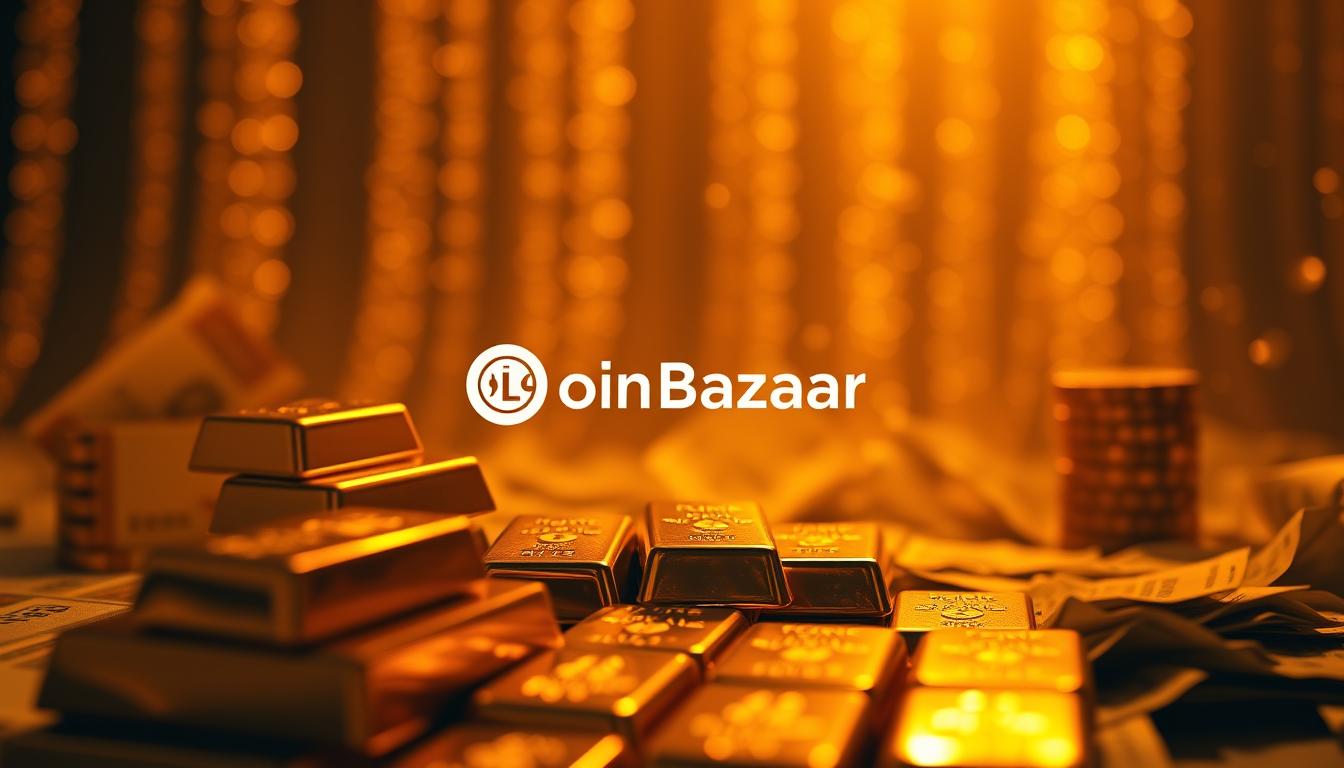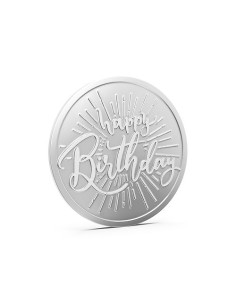Exclusive Deals & Trending Items
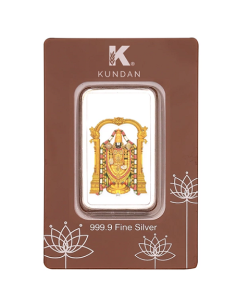

Kundan Color Tirupati Balaji Silver Bar of 100 Gram in 999.9 Purity / Fineness in Certi Card
Shop NowHave you seen how gold ETFs have grown in popularity since 2003? They’ve drawn in both big investors and everyday folks. This has changed how we think about precious metals investments.
The money in gold ETF investments has skyrocketed, hitting new highs. This move towards investing in gold ETFs has made people wonder about its effect on buying physical gold.
Key Takeaways
- The rise of gold ETFs has changed the investment landscape.
- Investors are increasingly turning to gold ETFs over physical gold.
- The impact of gold ETFs on physical bullion sales is significant.
- Understanding gold ETFs is crucial for making informed investment decisions.
- Gold ETFs offer a convenient and efficient way to invest in gold.
Understanding Gold ETFs: A Modern Investment Vehicle
Gold ETFs are a modern way to invest in gold. They let you trade gold like stocks, without owning physical gold. This makes investing in gold easier and more flexible.
What Are Gold ETFs and How Do They Work?
Gold ETFs track the gold price, so you can invest in gold without physical storage. They aim to match gold’s performance, offering returns based on gold’s price.
The Mechanics Behind Gold ETF Trading
Trading Gold ETFs is similar to trading stocks. You can buy and sell them through a brokerage account. They are traded on major stock exchanges, offering liquidity and flexibility.
Gold ETF Stock Symbols and Exchanges
Gold ETFs are listed on major exchanges with specific symbols. For example, some are traded on the NYSE Arca or NASDAQ. To invest, you need to know the symbol and have access to a trading platform.
Key Differences Between Gold ETFs and Other Gold Investments
Gold ETFs offer diversification and liquidity unlike physical gold or mutual funds. Here’s a comparison:
| Investment Type | Liquidity | Physical Ownership | Trading Platform |
|---|---|---|---|
| Gold ETFs | High | No | Stock Exchanges |
| Physical Gold | Low | Yes | Not Applicable |
| Gold Mutual Funds | Medium | No | Mutual Fund Platforms |
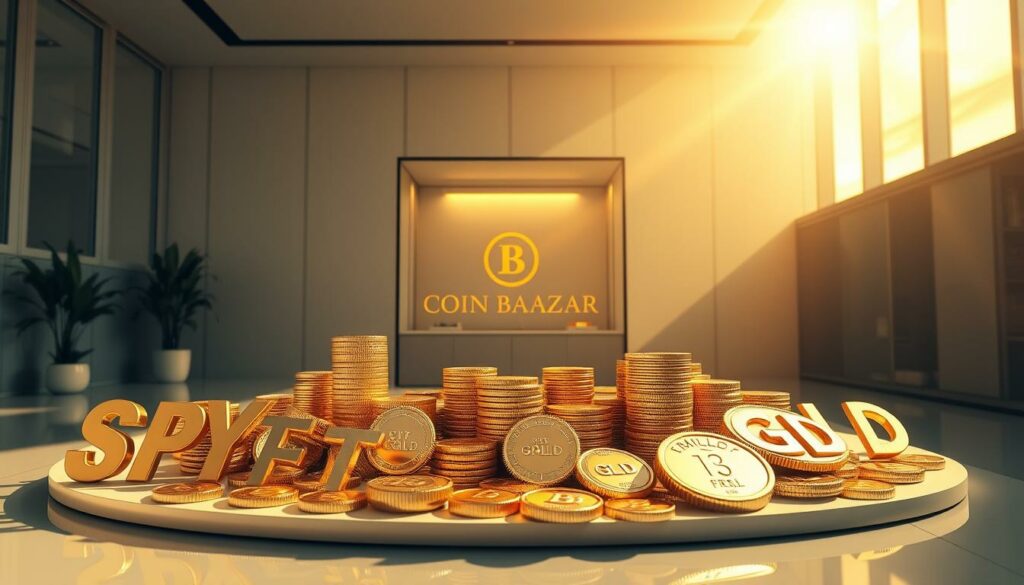

Understanding Gold ETFs helps you make smart investment choices. They can be a valuable part of your portfolio.
The Historical Evolution of Gold ETFs
Gold ETFs have grown a lot since the first one was introduced. This has changed how people invest in gold. It’s interesting to see how this investment tool came to be and how it has changed over time.
The First Gold ETF: Birth of a Revolutionary Investment Tool
The first Gold ETF was launched in 2003. This was a big step for gold investments. It let investors buy gold without having to hold the metal themselves.
This change made investing in gold easier and more varied. It opened up new ways for investors to put their money into gold.
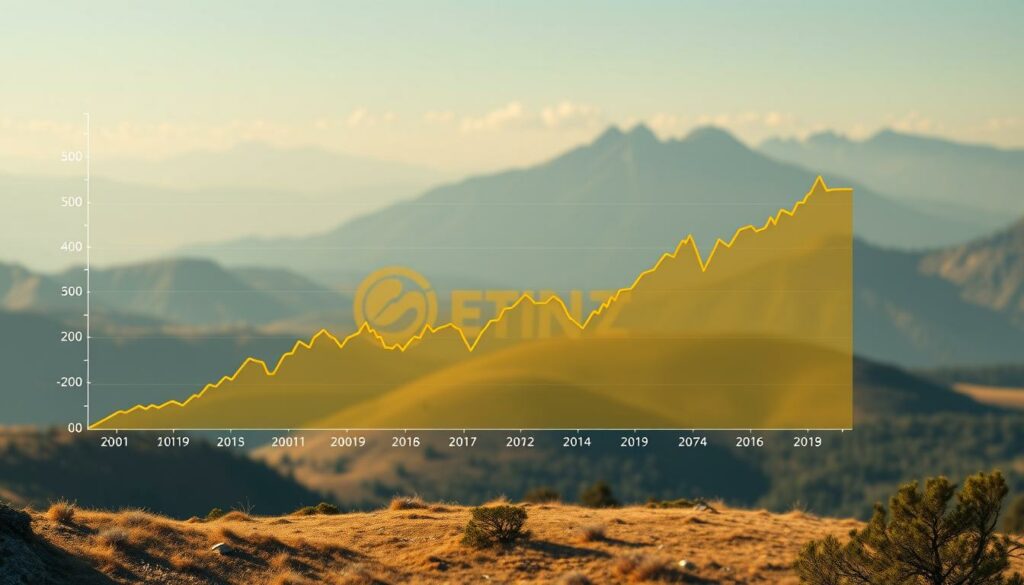

Growth Trajectory of Gold ETFs Globally
Gold ETFs have grown a lot worldwide. Now, there are many Gold ETFs for different investors. The money in Gold ETFs has also gone up a lot, hitting new highs.
Major Milestones in Gold ETF Development
Gold ETFs have had some big moments. Some key events include:
- The launch of the first Gold ETF in 2003
- Expansion into new markets and regions
- Innovations in product offerings, such as physically-backed and synthetic Gold ETFs
Market Capitalization Growth Over Time
The value of Gold ETFs has grown a lot. Here’s a table showing how much money is in Gold ETFs worldwide:
| Year | AUM (in billion USD) |
|---|---|
| 2003 | 1.2 |
| 2010 | 50 |
| 2020 | 250 |
The money in Gold ETFs has gone from $1.2 billion in 2003 to $250 billion in 2020. This shows a big increase in people’s interest in Gold ETFs.
Gold ETFs in the Indian Market: A Unique Perspective
Gold ETFs are gaining popularity in India. They offer a modern way to invest in gold. India is the second-largest gold consumer, making its investment patterns in gold significant.
Gold ETFs provide a new way to invest in gold. Investors don’t need to own physical gold.
Introduction and Adoption of Gold ETFs in India
The Indian gold ETF market has grown a lot since it started. Gold ETFs were first seen as a new investment product. Now, they are more accepted by Indian investors.
Key Players in the Indian Gold ETF Space
Some big names in the Indian gold ETF market are:
- Goldman Sachs Asset Management
- HDFC Asset Management Company
- ICICI Prudential Asset Management Company
These companies have helped make gold ETFs popular among Indian investors.
Growth Statistics and Market Penetration
The growth of gold ETFs in India is impressive. Assets under management (AUM) have grown a lot over the years. Some key statistics include:
- AUM in Indian gold ETFs has grown by over 20% annually in the last five years.
- The number of gold ETF schemes has increased, offering a range of options to investors.
Regulatory Framework and Market Structure
The regulatory framework for gold ETFs in India is overseen by the Securities and Exchange Board of India (SEBI). SEBI has set guidelines to make sure gold ETFs operate well and openly.
Key regulatory aspects include:
- SEBI makes sure gold ETFs hold physical gold in vaults, ensuring the gold’s authenticity and purity.
- Regular audits are done to check if SEBI guidelines are followed.
The Traditional Gold Market in India: Cultural and Economic Significance
The gold market in India is deeply connected to the country’s culture and economy. Gold has been a key part of Indian life, affecting culture and investment.
Gold’s Role in Indian Culture and Traditions
Gold is highly valued in Indian culture, playing a big role in traditions and ceremonies. It’s a big part of weddings and festivals, showing prosperity and luck. Gold is seen as a family treasure, passed down through generations.
For instance, during the festival of Akshaya Tritiya, Indians buy gold in large quantities, believing it to bring good luck and prosperity. This love for gold drives the demand for physical gold in India.
Physical Gold as an Investment in Indian Households
In Indian homes, gold is more than a cultural symbol; it’s a popular investment. People buy gold to protect against inflation and economic ups and downs. It’s easy to buy and sell, making it a favorite choice.
Investment in gold is often seen as a safe haven during times of economic volatility. Gold’s history as a value store supports this view.
Regional Variations in Gold Investment Preferences
Gold investment preferences vary by region in India. Southern India loves gold jewelry, while northern India prefers both jewelry and coins. Knowing these differences is key for investors and analysts.
| Region | Preferred Form of Gold | Investment Motivation |
|---|---|---|
| Southern India | Gold Jewelry | Cultural and Aesthetic |
| Northern India | Gold Jewelry and Coins | Investment and Cultural |
| Eastern India | Gold Coins and Bars | Investment |
Generational Differences in Gold Buying Habits
Gold buying habits change with age. Older folks like traditional gold jewelry, while younger people prefer modern Gold ETFs.
How Gold ETFs Are Changing Investment Patterns
Gold ETFs have changed how we invest in gold. They have brought in more investors and changed the way we buy gold.
Shifting Demographics of Gold Investors
Gold ETFs are attracting new types of investors. Younger and urban investors are drawn to their ease and flexibility.
Urban vs. Rural Adoption Trends
Gold ETFs are more popular in cities than in rural areas. This is because cities have better financial services and more awareness about gold ETFs.
Age and Income Factors in Gold ETF Investment
Younger and wealthier investors prefer gold ETFs. They like the digital platforms and want to diversify their investments.
New Investment Behaviors and Strategies
Gold ETFs are leading to new ways of investing. They make it easier to diversify and buy and sell gold.
The table below shows how gold ETF investors differ:
| Investment Behavior | Traditional Gold | Gold ETFs |
|---|---|---|
| Accessibility | Physical gold requires storage | Gold ETFs are traded on stock exchanges |
| Diversification | Limited to physical gold | Can be part of a diversified portfolio |
| Liquidity | Can be time-consuming to liquidate | High liquidity as they are traded on exchanges |
As gold ETFs grow in popularity, they will likely change investment patterns even more. They will attract more investors and grow the gold market.
Comparing Gold ETFs and Physical Bullion: Advantages and Disadvantages
When you explore gold investments, knowing the difference between Gold ETFs and physical bullion is key. Both are popular among Indian investors but serve different needs and tastes.
Benefits of Investing in Gold ETFs
Gold ETFs have many benefits that make them appealing. They are known for their liquidity and ease of use.
Liquidity and Convenience Factors
Gold ETFs trade on stock exchanges, making them easy to buy and sell. This ease is a big plus, especially for those who need quick access to their money. Plus, you don’t have to deal with physical gold, making them a hassle-free choice.
- Ease of buying and selling
- No storage concerns
- Ability to trade in small quantities
Cost Efficiency and Storage Benefits
Gold ETFs are also cost-effective. You don’t have to worry about the costs of storing physical gold. They also have lower expense ratios than many other investments.
Key benefits:
- Lower costs
- No storage hassles
- Transparency in holdings
Drawbacks and Limitations of Gold ETFs
Gold ETFs have their downsides too. Knowing these can help you make a better choice.
Counterparty Risks and Trust Concerns
One big worry with Gold ETFs is counterparty risk. Since they’re backed by physical gold, there’s a chance the custodian could default. Choosing reputable ETFs with strong custodial setups can help reduce this risk.
Emotional and Cultural Considerations
For many, physical gold holds cultural and emotional value. Gold ETFs might not offer the same satisfaction. It’s important to think about your personal and cultural values when deciding between ETFs and physical gold.
In summary, Gold ETFs provide a modern, easy, and affordable way to invest in gold. Yet, they also have their challenges. Understanding both sides can help you choose wisely, based on your goals and comfort with risk.
Impact of Gold ETFs on Physical Bullion Sales
Gold ETFs are becoming more popular, and they’re changing the traditional gold market. This includes how people buy physical bullion. It’s interesting to see how these modern investments affect the demand for real gold.
Statistical Analysis of Market Trends
The link between gold ETFs and physical bullion sales is complex. Gold ETFs make investing in gold easy without needing to store it physically. Yet, some investors still want the real thing.
Correlation Between ETF Inflows and Bullion Demand
Research shows a link between gold ETF inflows and physical bullion demand. Buying gold ETFs often shows a bigger trend in gold investment, including physical gold. But, the link isn’t always clear-cut. Sometimes, gold ETFs can replace physical gold instead of adding to it.
Seasonal Variations and Market Cycles
Seasons and market cycles affect both gold ETFs and physical bullion sales. For example, in India, the festive season boosts physical gold demand. Knowing these patterns helps investors in the gold market.
Case Studies: Markets with High Gold ETF Adoption
Let’s look at markets where gold ETFs are widely used. In these places, investors’ preferences for gold have shifted. In some Western markets, gold ETFs are more popular, which might lower physical bullion demand.
When making investment choices, keep these trends in mind. Gold ETFs are flexible and easy to invest in. But, physical gold still holds a special place, especially in cultures where gold is deeply rooted in traditions and investments.
Best Gold ETFs for Indian Investors
As an Indian investor, you might be looking into the best gold ETFs to add to your portfolio. The gold ETF market in India has grown a lot. It offers many options that track gold prices or invest in gold mining companies.
Top Performing Gold ETFs in the Indian Market
Many gold ETFs have done well in India. Look at their performance metrics and historical returns when choosing.
Performance Metrics and Historical Returns
Top gold ETFs usually give good returns that match gold prices. For example, some of the best gold ETFs have returns that match the gold market.
| Gold ETF | 1-Year Return | 3-Year Return |
|---|---|---|
| Gold ETF A | 10% | 25% |
| Gold ETF B | 9.5% | 24% |
| Gold ETF C | 10.2% | 26% |
Expense Ratios and Management Quality
When picking a gold ETF, think about the expense ratio and management quality. Lower expense ratios mean more money in your pocket.
Factors to Consider When Choosing a Gold ETF
When picking a gold ETF, look at a few things. These include tracking error, fund size, liquidity, and trading volume.
Tracking Error and Fund Size Considerations
A gold ETF with low tracking error is better because it closely tracks gold prices. Also, a bigger fund size means it’s more stable.
Liquidity and Trading Volume Analysis
Liquidity and trading volume are key too. More liquidity and trading volume make buying and selling easier without big price changes.
By looking at these factors and the top gold ETFs, Indian investors can make smart choices that fit their goals.
Gold ETF Performance: Historical Analysis and Benchmarks
Looking at the past performance of Gold ETFs can help us see their value as long-term investments. It’s key for investors to know how Gold ETFs have done over time. This knowledge helps in making smart choices.
Performance Metrics and Evaluation Criteria
There are several ways to measure Gold ETFs. We look at how well they match gold prices, their fees, and how often they trade.
Understanding Gold ETF Prices and Valuation
Gold ETF prices reflect the gold they hold. It’s important for investors to know what affects these prices. Things like gold’s current price and fees play a big role.
Benchmarking Against Gold Spot Prices
One important way to judge Gold ETFs is by how closely they follow gold’s spot price. A Gold ETF that closely matches gold’s spot price is usually a good choice.
Comparing Gold ETF Returns with Physical Gold
Investors often look at how Gold ETFs and physical gold compare. Both can be good investments, but they work differently.
Short-term vs. Long-term Performance Comparison
In the short term, Gold ETFs can be unpredictable due to market changes. But over time, they tend to act like physical gold.
Volatility and Risk Assessment
Gold ETFs, like any investment, carry risks. It’s crucial for investors to understand these risks. Market mood and economic signs can change how they perform.
| Performance Metric | Gold ETF | Physical Gold |
|---|---|---|
| Short-term Volatility | High | Low |
| Long-term Returns | Stable | Stable |
| Liquidity | High | Low |
By looking at these metrics and understanding Gold ETF history, investors can make better choices for their portfolios.
Gold ETF Comparison: Finding the Right Investment Vehicle
The gold ETF market has many options for investors. You can pick from domestic and international gold ETFs, and even specialized ones. Knowing the differences helps you make a smart choice.
Domestic vs. International Gold ETFs
Choosing between domestic and international gold ETFs depends on several things. Domestic ETFs are easier to understand because they’re in your local currency and follow local rules. International ETFs, however, let you invest in global gold markets, which can protect against local market drops.
Currency Risk and Global Market Exposure
International gold ETFs have currency risk because exchange rate changes can impact your investment. Yet, they also let you diversify by investing in global markets. For example, investing in a London gold market ETF means you’re part of that market’s dynamics.
Regulatory Differences and Investor Protections
Gold ETFs are regulated differently in various countries. It’s key to know these rules to protect your investment. Some countries have stricter rules or better investor protection laws.
Specialized Gold ETFs and Alternative Structures
There are also specialized gold ETFs with unique strategies. These include leveraged and inverse gold ETFs, and gold mining ETFs.
Leveraged and Inverse Gold ETFs
Leveraged gold ETFs try to increase gold returns using derivatives. Inverse gold ETFs let you make money when gold prices fall. These are more complex and riskier.
Gold Mining ETFs vs. Physical Gold ETFs
Gold mining ETFs invest in gold mining company stocks, giving indirect gold exposure. Physical gold ETFs hold actual gold, offering direct exposure. Your choice depends on your investment goals and how much risk you’re willing to take.
In conclusion, comparing gold ETFs is crucial for finding the right one for you. Consider factors like domestic vs. international, currency risk, and specialized strategies. This way, you can choose an investment that fits your goals.
How to Start Investing in Gold ETFs
Gold ETFs have made investing in gold easy and accessible. They are a great way to add gold to your investment mix. This makes it simpler than ever to get into the gold market.
Step-by-Step Guide for First-Time Investors
Investing in Gold ETFs is easy once you know how. First, you need to set up a demat account and trading platform. This is where you buy and sell Gold ETFs.
Setting Up a Demat Account and Trading Platform
To begin, open a demat account with a trusted brokerage firm that offers Gold ETFs. This account will hold your Gold ETF units digitally. Make sure the firm is registered and has a user-friendly platform.
Creating an Investment Strategy
Before you invest, set clear goals and understand your risk level. Think about your investment time frame and how Gold ETFs fit into your portfolio. A solid plan helps you make better choices.
Common Mistakes to Avoid
Investing in Gold ETFs can be good, but there are traps to avoid. Knowing these can help you move through the market better.
Timing the Market vs. Systematic Investment
Trying to time the market is risky. Instead, use a systematic investment plan. This means investing a set amount regularly, no matter the market. It can lessen the effect of ups and downs.
Portfolio Allocation Best Practices
Make sure your Gold ETF investment matches your financial goals and risk level. Diversifying and checking your investments often keeps you on course.
Tax Implications and Regulatory Considerations for Gold ETF Investors
When you think about investing in gold ETFs, knowing about taxes and rules in India is key. Gold ETFs, like other investments, face taxes and rules that can change your earnings.
Taxation of Gold ETFs in India
In India, gold ETFs are seen as equity funds if they hold 90% of their assets in gold. This affects their taxes a lot.
Short-term vs. Long-term Capital Gains
Gold ETFs have different tax rates for short-term and long-term gains. Short-term gains are taxed at 15%. Long-term gains over Rs. 1 lakh are taxed at 10%. Knowing the difference is important for planning taxes.
Tax Efficiency Compared to Physical Gold
Gold ETFs are more tax-friendly than physical gold. Physical gold doesn’t have capital gains tax after three years, but you miss out on indexation. Gold ETFs, however, get LTCG benefits with indexation.
“The tax efficiency of gold ETFs compared to physical gold can significantly impact an investor’s returns, making it a critical consideration for investment decisions.”
Regulatory Changes and Their Impact
The rules for gold ETFs in India are set by the Securities and Exchange Board of India (SEBI). Changes in these rules can greatly affect gold ETFs.
SEBI Guidelines and Investor Protections
SEBI rules make sure gold ETFs are open and safe. They require clear disclosure, fair valuation, and safe gold storage. These steps protect investors and keep the market fair.
Future Regulatory Developments
As the gold ETF market grows, new rules are likely. It’s important for investors to keep up with these changes. This could include tax policy updates or new SEBI rules.
Understanding taxes and rules helps you make better choices when investing in gold ETFs in India.
Conclusion: Balancing Traditional and Modern Gold Investments
The rise of gold ETFs has changed how we invest in gold. They offer a modern, easy way to invest instead of traditional physical gold. Gold ETFs have attracted a new group of investors and opened up new ways to diversify.
When you invest in gold ETFs, it’s key to look at their performance. Gold ETFs have done well, making them a good choice for those who want to invest in gold easily. This way, you don’t have to worry about storing physical bullion.
The gold ETF market is growing, and new products and strategies will come out. By knowing the good and bad of gold ETFs and keeping up with market trends, you can make smart choices. This helps you balance your traditional and modern gold investments.






